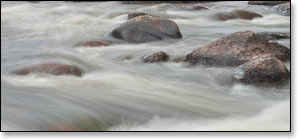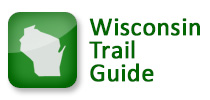Wolf River
(W2) Lily to Hollister, Wisconsin Trail Guide
Trail Facts
| Distance: | 6.4 miles |
| Skill Level: | Novice |
| Whitewater: | Class II |
| Approx. Paddle Time: | 3 hours |
| Elevation Drop: | 77 feet |
| Average Gradient: | 12.0 fpm |

Synopsis
Trail Review
This reach of the upper Wolf River features several long stretches of riffles, class I and class II rapids and boulder gardens. There are a large number of islands scattered throughout. In several areas the islands come in bunches, and the narrow channels can be fun to explore.
A beautiful northern-hardwood and mixed-pine forest surrounds the river along with occasional grassy banks, dense thickets and open wetlands. The Wisconsin DNR owns most of the land surrounding the river so you will see very little development.
Paddling This Segment
Below the Highway 52 bridge (Lily), the river runs through several long pitches of low-hazard boulder gardens and rapids. The first challenging whitewater occurs two and a half miles below the put-in, where the river bends sharply left and rushes through Big Slough Gundy Rapids, a rocky class II. A stretch of flatwater and numerous shallows follows before the river funnels into Little Slough Gundy Rapids, another class II that is the most difficult of this segment.
The river runs through more riffley shallows, then a pair of easy class I's; Big Sheen Rapids is first, followed by Little Sheen Rapids just downstream. Below Little Sheen, the river forks around several islands in a long stretch of flatwater with a few pitches of riffles and boulder gardens, all the way down to Hollister Road Landing.
This is a fun and and very scenic run for novice, whitewater enthusiasts.
Locals commonly refer to the stretch between Lily and Hollister as "Section 1"
Season
The Wolf is fed by a large number of springs and small tributaries which help maintain a consistently navigable flow throughout spring, summer and fall. Occasionally, the river may be too low for an enjoyable paddle during dry spells in summer and fall. However, when a sustained rainfall occurs river levels will rise rapidly and drop slowly - and paddling conditions will be good-to-excellent for an extended period of time.
River Level Information
The river gauge referenced below is located 8.3 miles downstream from this segment and should provide an accurate indication of current conditions in this reach. At higher levels, strainers and deadfall become more of a hazard when present.
River Gauge Location: USGS Gauge at Highway 64 Bridge near Langlade, northeast bank.
Suggested Minimum Level: 250 cfs
USGS Gauge Station: 04074950
Suggested River Levels:
| Below 250 cfs |
Paddling not recommended. |
| 250 cfs to 500 cfs |
Low runnable flow. Several of the rapids are likely scrappy in this range. |
| 500 cfs to 1000 cfs |
Very good range for novice whitewater paddlers. Class II run. Some rapids may still be bumpy rock-gardens at low end of this range. |
| 1000 cfs to 1400 cfs |
High runnable flow for novice whitewater enthusiasts. Unusually high flows. High speed current. Little Slough Gundy Rapids are approaching class III at high end of this range, may overpower less-experienced paddlers. |
| 1400 cfs to 2000 cfs |
Rare, unusually high flows. Novice paddlers should avoid the river. Little Slough Gundy Rapids likely producing class III waves and sticky holes. Riverbanks overflowing at around 1400 cfs. |
| Above 2000 cfs |
Rare, unusually high flows. Paddling not recommended. |

